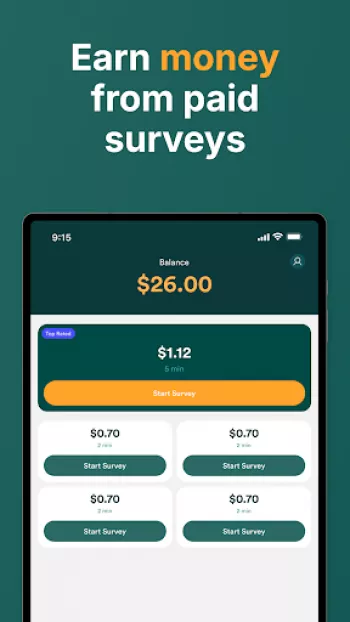Apps Home

MultiPolls - Surveys on The Go
Understanding the Dynamics of Interactive Polls and Surveys
Interactive polls and surveys have transformed the way we gather information in the modern era, acting as essential tools in fields ranging from marketing research to participatory democracy. Unlike traditional surveys, interactive versions engage users on a deeper level by incorporating dynamic interfaces and real-time feedback, making the process not only informative but also engaging. This engagement is driven by a human-centered approach that ensures participants are motivated to complete surveys because they see immediate results and receive incentives for their contributions. Polls, on the other hand, capture quick snapshots of opinions on current issues, often requiring only a single click or tap from respondents to cast their votes. The technical mechanics behind these tools involve sophisticated software frameworks capable of handling large volumes of data while ensuring privacy and security of personal information. Platforms that offer these interactive experiences, such as MultiPolls, integrate gamification techniques by rewarding users with cash or gift cards, thus tapping into intrinsic desires for competition and reward. For instance, a user might participate in a survey about a new product, and upon completion, receive instantaneous points or a chance to enter a draw, making the experience more than just an obligation, but a fun and rewarding challenge. These platforms often utilize algorithms to ensure the equity of rewards distribution, maintaining user trust and system integrity. Moreover, interactive polls can provide vital insights into cultural and socio-political sentiments, allowing organizations to tailor their strategies in real-time based on collective feedback. Therefore, the intersection of technology, psychology, and business models has produced a robust ecosystem wherein interactive polls and surveys can thrive, continually evolving to meet the demands of both researchers and willing participants.
The Role of User Experience in Polls and Surveys
User experience (UX) is paramount when developing interactive polls and surveys, primarily because the willingness of participants to engage directly impacts the quality and reliability of the collected data. Creating a seamless, intuitive interface that is responsive across devices is a critical aspect that developers focus on to ensure high participation rates. MultiPolls, for example, has optimized its design to ensure that users can navigate through surveys and polls effortlessly, they may even download the application on Android through the Download for Android link. Effective UX design takes into account the user's cognitive load, minimizing unnecessary information and guiding them through each step with clear instructions and feedback mechanisms. Interactive elements such as sliders, draggable options, and quick-select buttons facilitate user engagement by transforming what might otherwise be a monotonous task into an enjoyable activity. Additionally, real-time progress indicators can help in reducing dropout rates by visually communicating how much of the survey is left, something that is psychologically reassuring to participants. Importantly, these digital interfaces need to be accessible to individuals with disabilities, necessitating the inclusion of features such as screen reader compatibility and adjustable text sizes. The feedback loop is another crucial component of UX with a profound influence on participant satisfaction. Providing users insights into how their input is contributing to larger outcomes can empower them and increase future participation. In fact, platforms that transparently display real-time poll results not only make respondents feel heard but also create a sense of community around shared opinions, thereby enhancing user retention. As the landscape of digital interactions becomes more sophisticated, incorporating AI-driven personalization can further tailor the experience to individual preferences, suggesting polls and surveys that align with users' interests based on their past behaviors and inputs.
The Economic Impact of Interactive Polls and Surveys
The economic impact of interactive polls and surveys is significant, both for companies utilizing the data and for individuals participating in them. For businesses, the insights garnered from these tools inform strategic decisions related to product development, marketing strategies, and customer service innovations. Companies save significant resources by leveraging digital surveys to quickly ascertain market reactions and consumer trends, allowing them to shift strategies dynamically instead of relying on slower, traditional research methods. They can forecast demand more accurately, tailor customer experiences, and even perform competitive analyses based on user-reported data. From the perspective of survey participants, the economic benefits materialize more tangibly through the incentives offered by survey platforms like MultiPolls. Individuals can earn supplemental income by dedicating their insights and opinions to these channels. In an era where gig economies are becoming the norm, engaging in these activities provides financial flexibility and the autonomy to work from anywhere. Many users view participation in such surveys as a side hustle, with the added benefits of flexibility and minimal entry requirements. Moreover, the transactional nature of online surveys safeguards economic exchanges, ensuring users are compensated through reliable digital payment gateways like PayPal, making the process both secure and efficient. Interestingly, the interplay between these economic factors creates a self-sustaining ecosystem wherein companies gain valued insights and users receive tangible rewards, fostering continued engagement. Additionally, as data becomes a more vital asset in the digital economy, the value companies derive from accurate, timely insights can often eclipse the costs associated, thereby making interactive polls and surveys an investment with high returns on many fronts.
Advancements and Technologies Behind Interactive Polls and Surveys
The advancement of technology has spurred a new era of sophistication in interactive polls and surveys, driven by innovations in data analytics, artificial intelligence, and mobile technology. The use of AI in understanding participant responses not only enhances the accuracy of data interpretation but also personalizes the survey experience by predicting what users might find interesting or relevant. Machine learning algorithms can analyze vast arrays of data to identify patterns and trends that human analysts might overlook, continuously feeding back into the development of more refined survey instruments. Additionally, machine learning can automate the categorization of qualitative data, converting open-ended responses into quantifiable insights. Integration with mobile technologies has revolutionized accessibility and engagement; users can participate while on the go, increasing participation rates. The advent of Progressive Web Apps (PWAs) has further blurred the lines between traditional applications and web accessibility, providing a seamless user experience without the necessity for constant software updates. Security technologies such as blockchain and end-to-end encryption ensure data integrity and participant privacy, addressing one of the major concerns associated with online surveys. Platforms such as MultiPolls are also exploring the incorporation of digital identity verification technologies to combat fraud, ensuring that data collected is both genuine and representative. Furthermore, APIs and cloud services facilitate the integration of various data sources, enabling more comprehensive insights by combining internal company data with external user feedback. As these technologies evolve, they pave the way for more personalized, efficient, and scalable survey processes, which not only benefit organizations in their data collection efforts but also enhance user satisfaction and trust through transparent and secure interactions.
The Future Landscape of Interactive Polls and Surveys
As we gaze into the future of interactive polls and surveys, the horizon appears bright with opportunities and imminent innovations. One of the primary drivers of future growth in this field will be the increasing emphasis on real-time data analytics and predictive modeling. Enhanced data visualization techniques will accompany real-time analytics, offering users and companies the ability to see patterns and trends as they develop, rather than retrospectively. The potential integration of virtual reality (VR) and augmented reality (AR) technologies in creating more immersive survey experiences is also on the table, with the potential to engage users in environments that simulate real-world conditions for more accurate feedback. On another frontier, the ongoing conversation around data privacy and ethics will shape how surveys are conducted, with regulations requiring that data collection be transparent, consensual, and purpose-limited. As such, platforms will continually innovate how they structure permissions, ensuring compliance while maintaining user trust. Furthermore, the democratization of data analytics tools will empower smaller organizations and individual creators to harness the power of opinion data without needing extensive resources, widening the reach and applicability of surveys across industries. MultiPolls, with its expanding network of survey options and reward mechanisms, exemplifies a platform that not only adapts to current demands but is strategically positioned for these future trajectories. With social media integration, surveys can leverage viral trends, reaching a broader audience quickly and efficiently. Ultimately, the landscape will shift towards more user-driven designs, where participants have greater influence over the survey topics and formats, making their interactions even more meaningful and customized. Thus, the future of interactive polls and surveys is not only about advancing technology but also about enriching human interaction and decision-making processes in an increasingly digital world. Download for Android and start utilizing the power of interactive polls and surveys today.
Share Your Opinion
Your Email Will Not Be Published.
All Rights Reserved © Apps Home 2025


































Tatjana Ivančević Kranjčević
I downloaded the MultiPolls application recently, and regularly filled out the surveys that were available to me. The reward is instant, which I li...
Cheyenne Price
so far I've cashed out 2 or 3 times and I'm far from disappointed. My withdrawals hit my selected method within literally 5 minutes and the cash-ou...
nobomi khoza
One of the best survey apps. There are always surveys available throughout the day. It's easy to accumulate money to reach the payout threshold. Yo...
Claire Craze
I was very fortunate to come across this app as I was in search of an app that would allow me to participate in surveys and be reimbursed through P...
Harsh Raj
I've been using MultiPolls for a while now, and it's honestly one of the best survey apps out there. What sets it apart is the sheer number of surv...